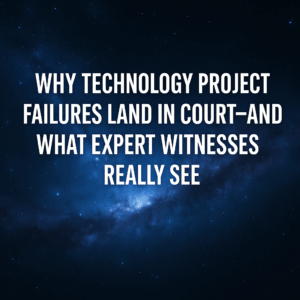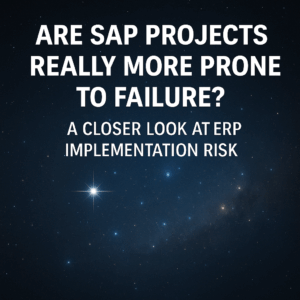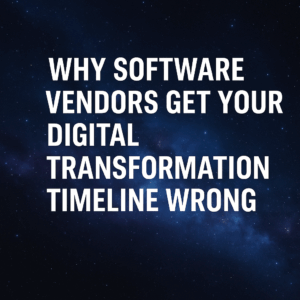When developing an effective digital transformation, there are several key decisions that should be aligned with a clear strategy and plan to work successfully. What are those significant evaluations that need to happen to be successful and ready for a digital transformation?
Here is everything you need to know…
There are a variety of strategic choices that you must be made with a digital transformation to accomplish the company goals. In fact, there are dozens or hundreds of decisions that need to be made throughout the project, maybe even thousands, depending on the type of organization you are. These fundamental decisions set the parameters and guardrails for an aligned project strategy.
These central conclusions need to be articulated, understood by the team, and ultimately part of the overall project governance to ensure alignment.
Table of Contents
ToggleLevel of Customization
The first decision that needs to be made as an organization is how customizable the digital transformation should be. I know what you’re thinking, “I’ve heard from everyone out there in the industry that I should not customize my software.” Well, the reality is that’s a noble vision and goal. To be honest, you’re probably not going to achieve it, most organizations don’t, nor should they.
Most technology is not going to fit 100% of the needs of a company, so there will likely be some level of customization to make the system work for the business. The question then becomes how much customization really needs to be done? It may be helpful to integrate and standardize the operations, business processes, and leverage off-the-shelf software, but be careful of too much change.
Chances are, it’s not an either-or answer. It’s not either there is customizing or there is not. Usually, it’s somewhere in the middle. Different parts of the business are going to have different answers. For example, functions like accounts payable or paying vendors faster, that may not be a competitive advantage for the organization so changing this process to fit a software might not be a big deal.
However, when it comes to the customer experience or how you’re going to manufacture the product, that may be a situation where you have a pretty good operating model that you want to retain. There are always going to be different levels of customization no matter the project.

Single System vs. Best of Breed
Enterprise Resource Planning (ERP Software) vendors have done a great job of selling a vision of utopia. This dreamland of one single system that’s going to do everything needed for the entire organization. This is a sales tactic as the majority of organizations aren’t going to find one system that can do everything.
The question then becomes, is one single ERP system the best option or specialized technologies for different parts of the business? Again, this isn’t a this or that answer. It’s somewhere in the middle for a lot of organizations.
Let’s say 60% – 80% of what the business needs is in one core ERP system, a best of breed focused solution can address the other departments or areas of the organization that the single ERP does not include.
For example, a solution like CRM for sales, or HCM for human capital management, or business intelligence. Those might be areas where you are going to accept and adopt best of breed, but you’re also going to use a core ERP system.
Going into this project, it’s important to understand the whole spectrum of a single system versus more of a best of breed approach to technologies.
Big Systems vs. Niche Tech
Similar to single systems versus best of breed, it’s important to consider the type of software vendors or implementation partners that will be the best fit for the organization.
Questions to consider throughout the evaluation process:
- Is the support of massive ERP vendors like SAP or Oracle or Microsoft the best solution?
- What is the company culture and does a potential vendor fit within the ecosystems?
- Is the technology a focus solution that’s specific to the industry or to certain functions within our business?
These are all important decisions to make because a lot of organizations get caught up in analysis paralysis, trying to figure out what the technology roadmaps are going to be without freezing up in the middle of it. It is all about honing in on those solutions that are going to be the best fit for the organization.
Vendors like Epicor and Infor provide core enterprise technologies that are not quite as big and complex as SAP or Oracle, but they’re not quite as small and niche as some of the other products out in the marketplace.
Understanding these different dynamics will help to ensure the project team is successfully blended across partners and the organization, as well as providing the best support for new technologies.

Magnitude of Change
Of all the things on the list so far, I think the one that’s the most overlooked is the magnitude of change. How much is an organization really willing to change and what are the risks associated?
If you’re an aggressive organization, or a young tech company that’s changing quickly, there may be a higher tolerance for risk, which might mean a different digital strategy approach based on that. It could also be that where you are today is not necessarily where you want to be in the future, but it’s not realistic to think that you’re going to shift one extreme to the other overnight or even in the short term. There needs to be a realistic approach to incremental changes.
One thing to note is sometimes, there is a choice involved regarding how much a business is willing to take on, but also, there are some industries and high growth models where change is immediate and inevitable.
For example, brick-and-mortar retailers after Covid-19 were forced into this whole e-commerce model if they wanted to survive. Whether they liked it or not, they had to do it. Now, this is the exception rather than the rule, but there needs to be a recognition of where the organization will be in the economy and the gross trajectory it will end up at.
The way the world is today, it is important to understand where the organization falls in that whole spectrum of the magnitude of risk and the magnitude of change as part of the digital strategy process. This is going to affect everything like:
- The types of technology that is deployed
- How vast the process improvements might be
- How quickly technology is deployed
- How much you might space out the deployment to be longer-term and more incremental
All those things are influenced by the magnitude of change.

Future State Operating Model
Probably the most complex and time-consuming aspect of our list is the future state operating model. These extremely significant layers of decisions need to be established very early in the digital transformation.
Now, the problem here is that most software vendors and system integrators will tell you that you don’t need to worry about this fundamental process. I’m here to tell you that is a complete myth, and that will set you on a track to a disaster if you follow that prescription.
It is critical to clearly define the future state, re-engineer business processes, and prospective roles and responsibilities of the workforce first. Then deploy the technologies that best fit these strategies.
If the technology is selected and deployed without that clear vision, what’s going to happen is one of two things:
- The organization is going to spend way too much time and money implementing the system because it doesn’t fit any of the current processes and there is no established strategy to evolve or change these processes
- Or, there will be silos of the current processes per singular areas of the business, data integration and optimization will be messy, and the different parts of the business operations aren’t clearly working toward a united goal.
Those are some things to think about. Having a clear operating model to serve as a blueprint for your digital transformation is of high importance.
Change Strategies
Another component that is often overlooked and needs to be a big decision that’s deliberately made early in a project is the change management strategy of the organization is.
- How are you going to enable human adoption?
- How are you going to bring people along?
- What are their roles and responsibilities going to look like?
- What are you going to do with that extra time that you have now automated or eliminated because of new technology?
Those are all choices that need to be made early on for a few reasons. It affects the overall business processes and future state. The best way to achieve the desired results or business value is to define a change management strategy that’s going to help the organization get to the end destination.
Unless the business is 100% automated (which is unheard of) then there is a people component that should be considered. Ultimately, an organization can implement the gold standard of innovative technology, but if the frontline behaviors are not leveraging it – it’s irrelevant. These user-adoption and change strategies need to be fully established prior to any technology change.
Data Migration
Another big decision that needs to be made is what is defining and implanting the data migration strategy into the business. There’s a whole lot of sub-decisions and micro-decisions that need to be made within this. At a high level, some of the key decisions need to be centered around the current data.
It’s easy to think that this is simply moving from an old to a new system. Yes, you can do that, but it’s going to take a lot of time to cleanse that data, map it to the new system, and ultimately migrate the data. On the other hand, it’s possible to just bring over master data and leave all the transactional data behind, but that’s going to create a lot of manual reworks.
The organization that has a clear vision of what to do with data and the overall data strategy will most likely have the best outcome within a digital transformation.

Solution Architecture & Integration
Now, the final thing to think about is the overall solution architecture. That decision needs to be made early in the project to have a clear roadmap for the technology that is going to be deployed. The integration process is important because that is where the data’s going to reside.
All these details including the migration process need to be defined.
If there is no clear solution architecture defined early on, then the implementation is going to take longer than planned. Also, the magnitude of change, project cost, business value metrics, etc. will lack any direction.
Resources
For more information on digital transformation best practices, I encourage you to check out the 2021 Digital Transformation Report. This features reviews and rankings of different software vendors in the marketplace, ERP, CRM, HCM vendors, etc. It will provide more depth and understanding of how to make your digital transformation and overall digital strategy successful.
I hope you found this information useful. If you have any questions regarding more about the importance of creating a digital strategy roadmap, please don’t hesitate to reach out to me directly. I am happy to be an informal sounding board as you move through your digital transformation journey.






